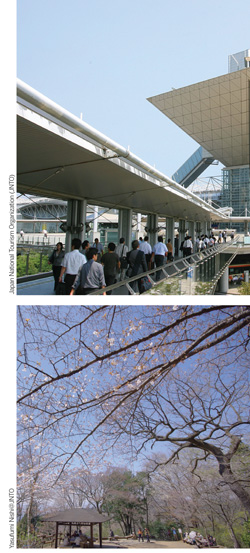
The 2020 Olympic Games hardware boost will make MICE players big winners when the event is over, writes Julian Ryall
With less than four years to go until the world’s largest sporting jamboree arrives in Tokyo, the city is making plans to ensure the 2020 Olympic Games is an efficient, attractive and unforgettable event. And business event players are delighted at the enhancements that are being planned as they know that once the show is over, they will be in prime position to take advantage.
“There will be a great deal of work done to the infrastructure of the city and the surrounding region, which will undoubtedly make life easier for MICE providers,” said Katsuaki Suzuki, executive director of the Japan Convention Bureau, the division of the Japan National Tourism Organisation tasked with developing the business events sector.
Among the new sporting facilities that are to be constructed, Suzuki pointed out a number are being designed to have dual uses after the Games, such as the 15,000-seat Ariake Arena where the volleyball competition will be held, and the new gymnastics stadium in the Ariake district of Tokyo, which will have 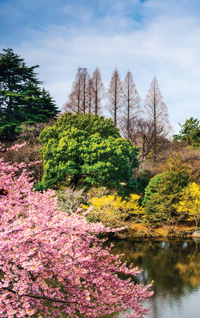 seating for 12,000 people.
seating for 12,000 people.
The Japanese government has also announced plans to enlarge both Haneda and Narita airports, adding runways and lifting annual arrival and departure slots by 79,000 flights a year by 2020. Meanwhile, the transport ministry is looking into ways to speed up immigration procedures.
Within Tokyo, a state-of-the-art terminal for long-distance buses opened in Shinjuku this April, while plans are also afoot for a new cruise terminal on Tokyo Bay.
The operator of the monorail that presently links Haneda airport with Hamamatsucho Station has announced that it will extend the line all the way to Tokyo Station.
“We believe the Games – and the run-up to the Games in Tokyo – will also help raise our profile as a destination for MICE,” remarked Suzuki. “We already have many conferences, exhibitions and so on, but we’re expecting more related to sporting themes as we get closer to 2020.”
An early promotion drive is planned for the Rio de Janeiro Olympic Games this summer, with Japan opening an online media centre providing easy access to detailed information on options in Tokyo over the next four years.
These broader developments mesh with a number of MICE-specific measures, Suzuki pointed out, such as the opening in early 2020 of a new 20,000m2 facility alongside the existing Pacific Convention Plaza Yokohama (commonly known as Pacifico Yokohama).

Similarly, the Japan Tourism Agency has started accepting applications for companies seeking financial support to use some of the city’s unique venues for events.
One of the locations being put forward under the programme is the Geihinkan State Guest House, which was until recently only open to the public on a limited number of days each year. Now, the venue can be used for private events, giving more people access to a building that is officially listed as a national treasure.
That’s exactly the sort of thing that would appeal to clients, according to Lucky Morimoto, president of Tokyo-based Event Services, Inc.
“Many of the firms that come to us do not want a generic location for their gala dinners or major events; they want something that is unique, traditionally Japanese and able to cater for up to 1,000 people,” explained Morimoto.
“Tokyo lacks something like that at the moment and I believe that if such a facility was built then it would be in great demand,” he added.
Morimoto believes that the new-found focus placed on Tokyo means that DMCs will “need to elevate their standards of service and their offerings”.
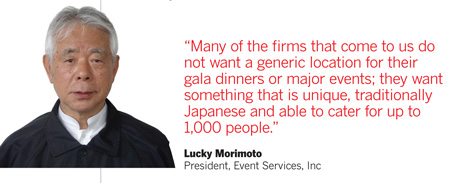
He said: “That is the main reason why I organised a group called The DMC Club, which meets once every two months to exchange information on unique venues or services that would be welcomed by our corporate event buyers.
“We do need to elevate our standards to be ready to welcome all the corporate buyers that we expect in the year of the Olympics.”
James Kent, sales and marketing manager for Tokyo-based The J Team DMC Co., also called for venues that have previously been declared off-limits to now be made accessible.
“I’m talking about temples, parks, special properties that today say they are not interested in hosting events, but need to realise that they have a very important role to play for the city,” he told TTGmice.
Unable to find a sufficiently large venue for one huge group recently, Kent’s company had to resort to using one of the exhibition halls at the Tokyo Big Sight convention centre for the gala dinner.
Management of the centre had never previously considered the space for such an event and it “was like watching a light bulb go on when they realised what was possible,” Kent added.
Another legacy that Kent hopes that the industry gains from the global spotlight in the lead up to and during the Games, will be that more DMCs attract a new influx of young people into their ranks. Too often, he said, event companies take on older workers seeking a “second life” job after they retire from another firm.
“One legacy that I hope we have beyond the Olympics is people looking at joining DMCs and looking at what they can achieve over the next 20 years rather than the five years until they finally stop working,” he said. “That would give the business a more sustainable boost.”
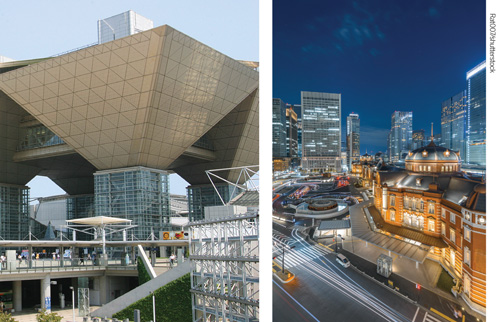
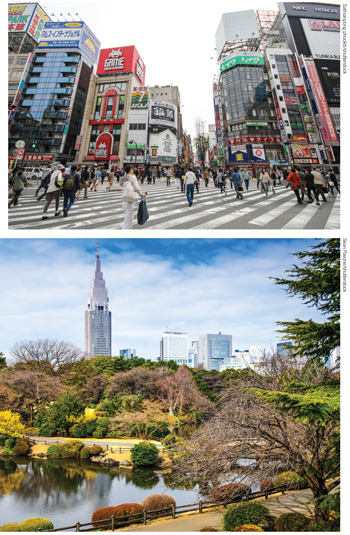
{Taking Numbers}
25
The number of years since Japan hosted the annual meeting
and general assembly of the International Association of Professional Congress Organisers. The event will be staged in Tokyo in 2018
355
The number of international association meetings held in Japan in 2015, a record annual high which places the nation seventh in the global rankings of host countries by ICCA
3,000
The size, in square metres, of the new TOC Gotanda Messe event space, which opened in January this year

{Developments to Watch}
![]() In June 2014, the 52-storey Toranomon Hills skyscraper changed the profile of the previously rather unremarkable district sandwiched between the more desirable Azabu and Roppongi districts. The eye-catching tower has office space, 25 restaurants, conference facilities and the Andaz Tokyo, the first boutique hotel by Hyatt Corporation in Japan. By 2020, Mori Building Co. plans to open a further three new tower complexes with facilities designed to turn the district into Tokyo’s newest global business hub.
In June 2014, the 52-storey Toranomon Hills skyscraper changed the profile of the previously rather unremarkable district sandwiched between the more desirable Azabu and Roppongi districts. The eye-catching tower has office space, 25 restaurants, conference facilities and the Andaz Tokyo, the first boutique hotel by Hyatt Corporation in Japan. By 2020, Mori Building Co. plans to open a further three new tower complexes with facilities designed to turn the district into Tokyo’s newest global business hub.

Toranomon Hills
Picture by Mori Building
![]() With an eye on the growing outbound travel demand from the Muslim nations in South-east Asia, the Tokyo Muslim Travellers’ Guide was published in April 2016. The English-language pamphlet provides details of hotels and dining establishments that are especially accommodating to Muslim visitors, and will benefit both leisure travellers and corporate groups with Muslim delegates. The project is part of the broader omotenashi long-term vision for Tokyo, to roll out a warm welcome to all international visitors.
With an eye on the growing outbound travel demand from the Muslim nations in South-east Asia, the Tokyo Muslim Travellers’ Guide was published in April 2016. The English-language pamphlet provides details of hotels and dining establishments that are especially accommodating to Muslim visitors, and will benefit both leisure travellers and corporate groups with Muslim delegates. The project is part of the broader omotenashi long-term vision for Tokyo, to roll out a warm welcome to all international visitors.
![]() The Tama district of western Tokyo has emerged as a hot-spot for incentive groups. Even though it is within the metropolitan area and a mere hour from central Tokyo, the region has some of the best green spaces in Kanto. Top of that list is Mount Takao, which was designated as a three-star destination on France’s famous Michelin Green Guide to Japan. Hiking up Mount Takao makes an execellent teambuilding activity. Chair lifts and cable cars are available to make the journey much easier. Other attractions in the area include a tour of a sake brewery and soba noodle-making.
The Tama district of western Tokyo has emerged as a hot-spot for incentive groups. Even though it is within the metropolitan area and a mere hour from central Tokyo, the region has some of the best green spaces in Kanto. Top of that list is Mount Takao, which was designated as a three-star destination on France’s famous Michelin Green Guide to Japan. Hiking up Mount Takao makes an execellent teambuilding activity. Chair lifts and cable cars are available to make the journey much easier. Other attractions in the area include a tour of a sake brewery and soba noodle-making.





















